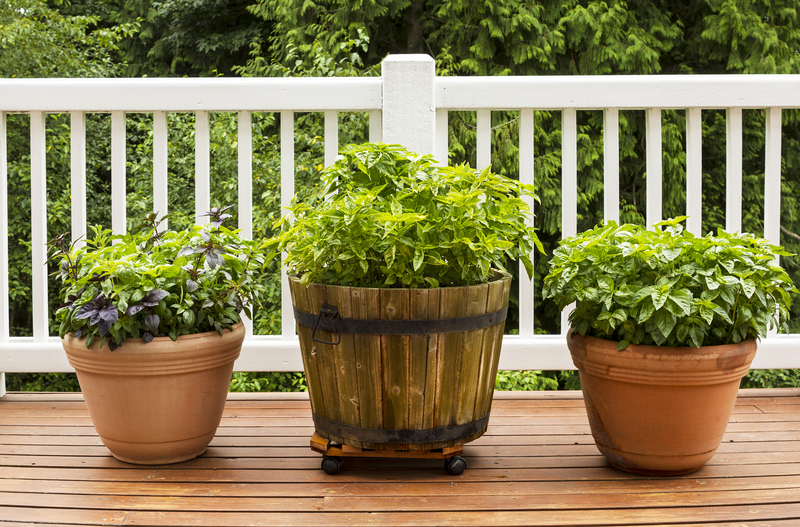Best Tools and Tricks for Getting Rid of Tree Stumps
Tree stumps can be unsightly, hazardous, and often inhibit your landscaping plans. Whether you recently felled a tree or inherited a property littered with leftover stump eyesores, you'll want to remove them effectively. This comprehensive guide explores the best tools for stump removal, advanced tricks, safety tips, and smart advice to make your yard stump-free while saving you time and effort.

Why Remove Tree Stumps?
Getting rid of tree stumps is more than a matter of aesthetics. Here's why you should consider tree stump removal as a priority:
- Pest Prevention: Decaying stumps attract termites, ants, beetles, and fungi, which might spread to healthy trees or even your home.
- Safety Hazards: Stumps present tripping risks, particularly for children and the elderly.
- Land Use: They obstruct mowing, landscaping, and garden layouts.
- Regrowth Prevention: Some species sprout suckers, turning one stump into many new trees.
Overview: Stump Removal Methods
When planning to manage tree stumps, you have several options. Your choice depends on the stump size, tree species, time, and your landscaping goals:
- Manual Removal: Physical extraction using hand and power tools.
- Chemical Stump Removal: Applying chemicals to accelerate decomposition.
- Stump Grinding: Mechanical removal with a specialized grinder.
- Natural Decay: Composting or rotting stumps in place with or without added accelerants.
- Burning: Using controlled fire to incinerate the stump (where permitted).
Manual Tree Stump Removal: Tools and Step-by-Step Guide
Manual removal is favored for small-to-moderate stumps and when heavy machinery isn't available. Here's what you'll need and how to do it:
Essential Tools for Manual Stump Removal
- Mattock or Pickaxe: To break the soil and roots.
- Digging Shovel or Spade: For excavating dirt around the stump.
- Pruning Saw or Bow Saw: Cuts through exposed roots.
- Axe or Hatchet: Chops thick roots with precision.
- Loppers: For cutting smaller roots quickly.
- Root Saw: An efficient serrated blade to saw through larger root systems.
- Steel Digging Bar: A heavy tool to lever stubborn roots.
- Chainsaw: (For advanced DIYers) Cuts the stump as flush to the ground as possible.
- Wheelbarrow: For hauling debris and roots away.
- Heavy-Duty Gloves and Eye Protection: Essential safety gear to avoid injuries.
Step-by-Step Manual Stump Removal Trick
- Trim the Stump Short: Use a saw or chainsaw to cut the stump as close to the ground as possible. This minimizes labor and reduces leverage for stubborn stumps.
- Expose the Roots: Dig around the base to reveal the main roots. The wider the excavation, the easier to cut and lift.
- Sever Roots: Use an axe, root saw, or loppers to slice through all visible roots. Don't forget to check below ground.
- Loosen and Pry: Rock the stump using your mattock or digging bar. Pry out loosened roots and cut any that resist.
- Pull Out the Stump: For tougher stumps, consider using a rope or chain attached to a vehicle (only if safe and legal in your area). Gently apply force until the root ball releases.
- Fill the Hole: Backfill the crater with soil and top it off with grass seed or sod as desired.
Manual stump removal is labor-intensive but effective for smaller stumps and gives you clean, immediate results.
Tree Stump Grinding: Quick and Efficient
For larger or industrial-sized stumps, stump grinding is the gold standard. This process uses a powerful machine to shred the stump and roots into mulch.
Best Tools for Stump Grinding
- Stump Grinder: A gasoline-powered machine with a rotating cutting wheel that chips away wood. They come in various sizes (from walk-behind to large wheeled machines).
- Chainsaw: For leveling the stump prior to grinding, if necessary.
- Safety Equipment: Ear protection, eye goggles, sturdy footwear, gloves, and in some cases, a dust mask.
Stump Grinding Process: Pro Tips
- Check Local Regulations: Rent or hire a stump grinder only where noise/pollution ordinances allow it.
- Prepare the Area: Remove stones, debris, and obstacles. Trim the stump flush to the ground.
- Operate the Grinder: Follow manufacturer instructions and keep bystanders at a safe distance. Sweep the grinder from side to side, gradually going deeper into the wood and upper root system.
- Mulch and Clean Up: Use wood chips as mulch around your garden--or dispose of them as per your city's guidelines.
- Soil Rebuilding: Fill the cavity with soil and replant grass as desired.
Stump grinding removes visible stumps fast and prevents regrowth, though some deeper roots may stick around but won't resprout.
Chemical Tree Stump Removal: Slow but Simple
If you're seeking a less laborious way to dissolve a tree stump, consider chemical removal. This method hastens decomposition.
Top Chemicals for Stump Removal
- Potassium Nitrate (Stump Remover): The primary ingredient in most commercial stump removal products, accelerating rot.
- Epsom Salt: A natural option that draws moisture from the wood, quickening decay.
- High-Nitrogen Fertilizer: Promotes microbial activity and wood breakdown.
Chemical Stump Removal Instructions
- Drill Holes: Using a wide drill bit (at least 1/2 inch), bore multiple holes deep into the stump from the top and sides.
- Fill with Chemical: Pour your chosen chemical (potassium nitrate, Epsom salt, or fertilizer) into the holes, then add hot water to activate.
- Cover and Wait: Place a tarp or heavy trash bag over the stump to trap moisture and heat, further speeding decomposition.
- Monitor Progress: After a few weeks or months, the wood will become soft. Chop away at the decaying stump and repeat the process as needed until all that's left is mulch.
- Dispose and Restore: Once decomposed, remove remaining debris and backfill the hole.
Note: Always follow label guidelines, wear gloves, and keep pets and children away from treated stumps.
Burning Tree Stumps: Beware the Risks
In some regions, supervised burning is a valid tree stump removal trick. While it's effective, burning stumps involves serious risks.
How to Burn a Tree Stump Safely
- Check Local Laws: Burning is often banned in urban or fire-prone areas.
- Prepare the Stump: Drill holes to improve airflow and fill with accelerants like potassium nitrate or kerosene (never gasoline).
- Ignite and Supervise: Light the stump, covering it partially with a metal barrel to contain flames. Supervise at all times with ample water and fire-extinguishing equipment on hand.
- Finish and Clean: After complete combustion, break up the ashes and remove leftover debris.
Warning: Burning can damage surrounding plants, soils, and cause wildfires. Always secure permits and review local regulations before using fire on your property.
Natural Stump Removal: Patience Pays Off
If you're not in a rush, letting nature reclaim the stump is environmentally friendly. Accelerate decomposition with a few clever tricks:
- Keep Moist: Soak the stump regularly to support fungal and microbial breakdown.
- Add Compost: Cover with a thick layer of rich compost, manure, or topsoil to introduce decay-causing organisms.
- Cover with Tarp: Trap humidity by blanketing the stump, which also blocks sunlight and speeds up softening.
- Drill Holes: As in chemical methods, this provides entryways for organisms and moisture.
- Inoculate with Mushrooms: Specialty fungi like oyster mushrooms can help degrade hardwood stumps--an eco-friendly (and tasty!) option.
Innovative and Lesser-Known Tree Stump Removal Tricks
Winch and Lever Systems
For remote stumps where vehicles can't reach, a hand winch (come-along) and fulcrum lever can help uproot stubborn stumps. Attach the winch to a solid anchor, use a digging bar for leverage, and alternate tension and cutting.
Excavator and Mini-Backhoe Rental
Large properties with multiple or sizable stumps may justify heavy equipment. Renting a mini-excavator or backhoe makes light work of clusters of stumps, especially if you're landscaping extensively.
Biodegradable Stump Remover Innovations
Some modern stump removers harness enzymes and beneficial bacteria rather than harsh chemicals, promoting eco-safe decay without future planting concerns.
High-Power Air Spade
An air spade (pneumatic soil excavator) can quickly expose roots around the base, causing less damage to surrounding soil structure--excellent for gardeners striving for minimal disturbance.
Tips for Choosing the Best Method to Remove Tree Stumps
- Stump Size: Manual and chemical methods suit small stumps; grinders or machines are better for larger ones.
- Tree Species: Hardwoods (oak, maple) take longer to decompose than softwoods (pine, poplar).
- Timeline: Manual and grinding methods are fastest; chemical and natural decay take weeks to years.
- Budget: Manual removal is cheapest but most physical. Renting grinders or machinery costs more, but saves on labor.
- Safety Considerations: Always use the right gear and follow proper procedures to avoid injuries.
- Environmental Impact: Natural or biodegradable products protect your soil for future planting.
Aftercare: Restoring Your Yard Post-Stump
Once the stump is gone, remediate the site to prevent sinkholes and future issues:
- Backfill Properly: Use local soil, tamping as you go to prevent settling.
- Add Topsoil: Top off with nutrient-rich topsoil and compost for replanting.
- Install Sod or Seed: Lay seed or sod quickly for fast groundcover restoration.
- Monitor for Sprouts: Some species may send up new shoots; treat these promptly to prevent regrowth.

Safety First: Protect Yourself and Your Property
Tree stump removal can be hazardous. Prioritize personal safety:
- Wear Gear: Gloves, goggles, ear protection, and steel-toed boots are essential.
- Work Clear of Bystanders: Keep children and pets well away from work areas.
- Mind Overhead Lines and Utilities: Call your local utility locator before digging deeply or operating heavy machinery.
- Read Equipment Guides: Always operator's manuals for power tools and stump grinders.
- Check Weather: Avoid stump removal in storms, high winds, or extreme heat for safety.
Conclusion: Reclaim Your Landscape
Getting rid of tree stumps doesn't have to be a daunting task. Whether you opt for manual labor, stump grinding, safe chemical methods, burning, or simply letting nature do its job, the right stump removal tool and method depend on your needs and resources. With some know-how, patience, and the proper equipment, you'll enjoy a beautiful, hazard-free yard ready for your next landscaping masterpiece. Choose the best way to remove tree stumps that fits your timeline, budget, and commitment to safety--and say goodbye to those unsightly remains once and for all!